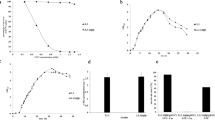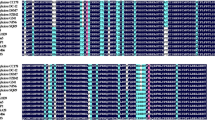Abstract
It is not easy to manipulate biosynthetic genes of Bacillus thuringiensis since there is a powerful methyl-specific restriction system in this microorganism. In this study, a PCR-based system was used to delete polyphosphate kinase gene (ppk) of Bacillus thuringiensis israelensis (Bti) by replacing the wild-type gene with a cassette containing the apramycin resistance gene as selectable marker. λ-Red was used to promote recombination in Escherichia coli between a PCR-amplified apramycin resistance cassette (linear deletion cassette selectable in E. coli and Bti) and Bti DNA on a plasmid. The isolated mutant plasmid was transferred to Bti by conjugation. Double cross-over transformants were screened for their antibiotic resistance and the mutation was proven by PCR, southern blot hybridization and RT-PCR. The described method, which uses the advantage of quick plasmid construction in E. coli and simple transformation of linear deletion cassette, is very useful to delete entire gene/genes of Bti without any polar effects on genes transcriptionally downstream.
Similar content being viewed by others
Abbreviations
- aac(3)IV :
-
aminoglycoside 3-N-acetyltransferase gene
- Ap:
-
ampicilin
- Apr:
-
apramycin
- BHI:
-
brain heart infusion
- Bti :
-
Bacillus thuringiensis subsp. israelensis
- Chl:
-
chloramphenicol
- Er:
-
erythromycin
- ermB :
-
rRNA adenine N-6-methyltransferase gene
- Kn:
-
kanamycin
- LB:
-
Luria Bertani
- ppk :
-
polyphosphate kinase gene
References
Abremski K., Hoess R. & Sternberg N. 1983. Studies on the properties of P1 site-specific recombination: evidence for topologically unlinked products following recombination. Cell 32: 1301–1311.
Arantes O. & Lereclus D. 1991. Construction of cloning vectors for Bacillus thuringiensis. Gene 108: 115–119.
Bone J. & Ellar D.J. 1989. Transformation of Bacillus thuringiensis by electroporation. FEMS Microbiol. Lett. 58: 171–177.
Cherepanov P.P. & Wackernagel W. 1995. Gene disruption in Escherichia coli: TcR and KmR cassettes with the option of Flp-catalyzed excision of the antibiotic-resistance determinant. Gene 158: 9–14.
Crickmore N., Zeigler D.R., Feitelson J., Schnepf E., Van Rie J., Lereclus D., Baum J. & Dean D.H. 1998. Revision of the nomenclature for the Bacillus thuringiensis pesticidal crystal proteins. Microbiol. Mol. Biol. Rev. 62: 807–813.
Datsenko K.A. & Wanner B.L. 2000. One-step inactivation of chromosomal genes in Escherichia coli K-12 using PCR products. Proc. Natl. Acad. Sci. USA 97: 6640–6645.
Delecluse A., Charles J.F., Klier A. & Rapoport G. 1991. Deletion by in vivo recombination shows that the 28-kilodalton cytolytic polypeptide from Bacillus thuringiensis subsp. israelensis is not essential for mosquitocidal activity. J. Bacteriol. 173: 3374–3381.
Fabret C., Ehrlich S.D. & Noirot P. 2002. A new mutation delivery system for genome-scale approaches in Bacillus subtilis. Mol. Microbiol. 46: 25–36.
Gust B., Challis G.L., Fowler K., Kieser T. & Chater K.F. 2003. PCR targeted Streptomyces gene replacement identifies a protein domain needed for biosynthesis of the sesquiterpene soil odor geosmin. Proc. Natl. Acad. Sci. USA 100: 1541–1546.
Hanahan D. 1985. Techniques for transformation of E. coli, pp. 109–135. In: Glover D.M. (ed.), DNA Cloning: A Practical Approach, IRL Press, Oxford.
Janes B.K. & Stibitz S. 2006. Routine markerless gene replacement in Bacillus anthracis. Infect. Immun. 74: 1949–1953.
Klimowicz A.K., Benson T.A. & Handelsman J. 2010. A quadruple-enterotoxin-deficient mutant of Bacillus thuringiensis remains insecticidal. Microbiology 156: 3575–3583.
MacNeil D.J., Gewain K.M., Ruby C.L., Dezeny G., Gibbons P.H. & MacNeil T. 1992. Analysis of Streptomyces avermitilis genes required for avermectin biosynthesis utilizing a novel integration vector. Gene 111: 61–68.
Paget M.S.B., Chamberlin L., Atrih A., Foster S.J. & Buttner M.J. 1999. Evidence that the extracytoplasmic function sigma factor σ E is required for normal cell wall structure in Streptomyces coelicolor A3 (2). J. Bacteriol. 181: 204–211.
Poncet S., Anello G., Delecluse A., Klier A. & Rapoport G. 1993. Role of the CryIVD polypeptide in the overall toxicity of Bacillus thuringiensis subsp. israelensis. Appl. Environ. Microbiol. 59: 3928–3930.
Salamitou S., Ramisse F., Brehelin M., Bourguet D., Gilois N., Gominet M., Hernandez E. & Lereclus D. 2000. The plcR regulon is involved in the opportunistic properties of Bacillus thuringiensis and Bacillus cereus in mice and insects. Microbiology 146: 2825–2832.
Sambrook J., Fritsch E.F. & Maniatis T. 1989. Molecular Cloning: A Laboratory Manual, 2nd Ed, Cold Spring Harbor Laboratory Press, Cold Spring Harbor, NY.
Shevchuk N.A., Bryksin A.V., Nusinovich Y.A., Cabello F.C., Sutherland M. & Ladisch S. 2004. Construction of long DNA molecules using long PCR-based fusion of several fragments simultaneously. Nucleic Acids Res. 32: e19.
Southern E.M. 1975. Detection of specific sequences among DNA fragments separated by gel electrophoresis. J. Mol. Biol. 98: 503–517.
Sun W., Wang S. & Curtiss III R. 2008. Highly efficient method for introducing successive multiple scarless gene deletions and markerless gene insertions into the Yersinia pestis chromosome. Appl. Environ. Microbiol. 74: 4241–4245.
Tunca S., Barreiro C., Coque J.J., Sola-Landa A. & Martin J.F. 2007. Transcriptional analysis of the iron regulation and desferrioxamine gene cluster of Streptomyces coelicolor A3(2). FEBS J. 274: 1110–1122.
Uzzau S., Figueroa-Bossi N., Rubino S. & Bossi L. 2001. Epitope tagging of chromosomal genes in Salmonella. Proc.Natl. Acad. Sci. USA 98: 15264–15269.
Vagner V., Dervyn E. & Ehrlich S.D. 1998. A vector for systematic gene inactivation in Bacillus subtilis. Microbiology 144: 3097–3104.
Xin Y., Yu H.J., Hong Q. & Li S.P. 2008. Cre/lox system and PCR based genome engineering in Bacillus subtilis. Appl. Environ. Microbiol. 74: 5556–5562.
Author information
Authors and Affiliations
Corresponding author
Rights and permissions
About this article
Cite this article
Doruk, T., Gedik, S.T. An efficient gene deletion system for Bacillus thuringiensis . Biologia 68, 358–364 (2013). https://doi.org/10.2478/s11756-013-0184-4
Received:
Accepted:
Published:
Issue Date:
DOI: https://doi.org/10.2478/s11756-013-0184-4




